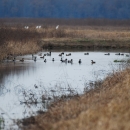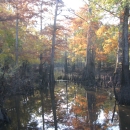Visit Us
The public is encouraged to explore our natural resources year-round. Hunting, fishing, hiking, canoeing, and wildlife viewing opportunities attract many outdoor enthusiasts. Visitors have access to several boat ramps, primitive campgrounds, fishing piers, three water trails, and two hiking trails. Stop by the visitor center to learn about the refuge’s history, management, and local flora and fauna.
Certain parts of the refuge may be inaccessible at times due to flooding. Biting insects, venomous snakes, and briars are common, so it is recommended that visitors bring drinking water, snacks, sunscreen, insect repellent, wear long pants, and site-appropriate footwear. It is also recommended that visitors wear applicable hunter orange while on the refuge during the gun and muzzleloader deer hunts.
Feel free to contact us for the most up-to-date information about activities and accommodations.
Refuge Access Permits are required for all refuge users.
When signed and in your possession (paper copy or digitally on your phone), the cover section of the Public Use Regulations brochure serves as your Refuge Access permit for all refuge hunts (except all Quota Hunts) and other permissible activities and acknowledges your understanding of the regulations contained within. You may pick up a Public Use Regulations brochure at the refuge headquarters, from brochure boxes near the entrance of refuge access roads, or you can download one from our website.
Activities
Felsenthal National Wildlife Refuge offers a wide array of activities. From fishing to environmental education, we offer something for everyone.
Trails
Felsenthal National Wildlife Refuge is a great place to watch wildlife and is a designated Important Bird Area by Arkansas Audubon. Whether it's hiking or paddling you are in the mood for, ease your cravings here. Our self-guided land and water trails provide visitors an opportunity to get out and explore.
Other Facilities in the Complex
A National Wildlife Refuge Complex is an administrative grouping of two or more refuges, wildlife management areas, or other refuge conservation areas that are primarily managed from a central office location. Refuges are grouped into a complex structure structure
Something temporarily or permanently constructed, built, or placed; and constructed of natural or manufactured parts including, but not limited to, a building, shed, cabin, porch, bridge, walkway, stair steps, sign, landing, platform, dock, rack, fence, telecommunication device, antennae, fish cleaning table, satellite dish/mount, or well head.
Learn more about structure because they occur in a similar ecological region, such as a watershed or specific habitat type, and have a related purpose and management needs. Typically, a project leader or complex manager oversees the general management of all refuges within the complex and refuge managers are responsible for operations at specific refuges. Supporting staff, composed of administrative, law enforcement, refuge manager, biological, fire, visitor services, and maintenance professionals, are centrally located and support all refuges within the complex.
Rules and Policies
Public Use Regulations are designed to protect the sportsman and wildlife populations. The Public Use Regulations provided for Felsenthal NWR supplement the general regulations which govern all public uses on National Wildlife Refuges as set forth in Title 50, Code of Federal Regulations. Hunting and fishing regulations are in accordance with applicable State regulations.
Refuge Access Permits are required for all refuge users. When signed and in your possession, the cover section of the Public Use Regulations brochure serves as your Refuge Access permit for all refuge hunts (except all Quota Hunts) and other permissible activities and acknowledges your understanding of the regulations contained within. You may pick up a Public Use Regulations brochure at the refuge headquarters, from brochure boxes near the entrance of refuge access roads, or you can download one from our website.
A Special Use permit is required for all commercial activities on the refuge, including (but not limited to) commercial fishing, fishing tournaments, trapping, commercial filming or photography, and collecting plants or mussels. Permits may be obtained by contacting our refuge headquarters with a formal request. All Special Use permit applications are subject to a two-week turnaround time.
For information about state regulations, boat registration, or hunting and fishing licenses, contact a regional Arkansas Game and Fish Commission office or visit their website.
Locations













The Visitor Center is located about 7 miles west of Crossett, Arkansas on US Highway 82.


